Abstract
To investigate the mechanism of recombination of immunoglobulin heavy chain variable and constant region genes, we have determined the nucleotide sequence of a large portion of the recombination region between an active C mu gene and its associated VH gene, isolated from an IgM-secreting mouse plasmacytoma, HPC76. By comparison with the sequence of the mu mRNA, we determined the exact boundaries of the intervening sequence between the VH76 and C mu genes. The rearranged VH76 gene encodes up to amino acid 116 without interruption, the 3' 39 nucleotides (the JH76 region) being derived from an embryonic JH segment (JH315) whose sequence was recently determined [Early, P., Huang, H., Davis, M., Calame, K. & Hood, L. (1980) Cell 195, 981-992]. The active JH76 does not use the first two codons of the embryonic JH315 from which it is derived. This indicates that V-J recombination is important in generating diversity within the third hypervariable region of heavy chains. We have identified another JH segment (JHA4), located 336 nucleotides 3' to the rearranged JH76 segment. This JH segment is expressed in the heavy chains of anti-levan myeloma proteins, which have truncated third hypervariable regions. We propose that the nucleotide sequence 5' to JHA4 is important for generating V region genes with shortened third hypervariable regions.
Full text
PDF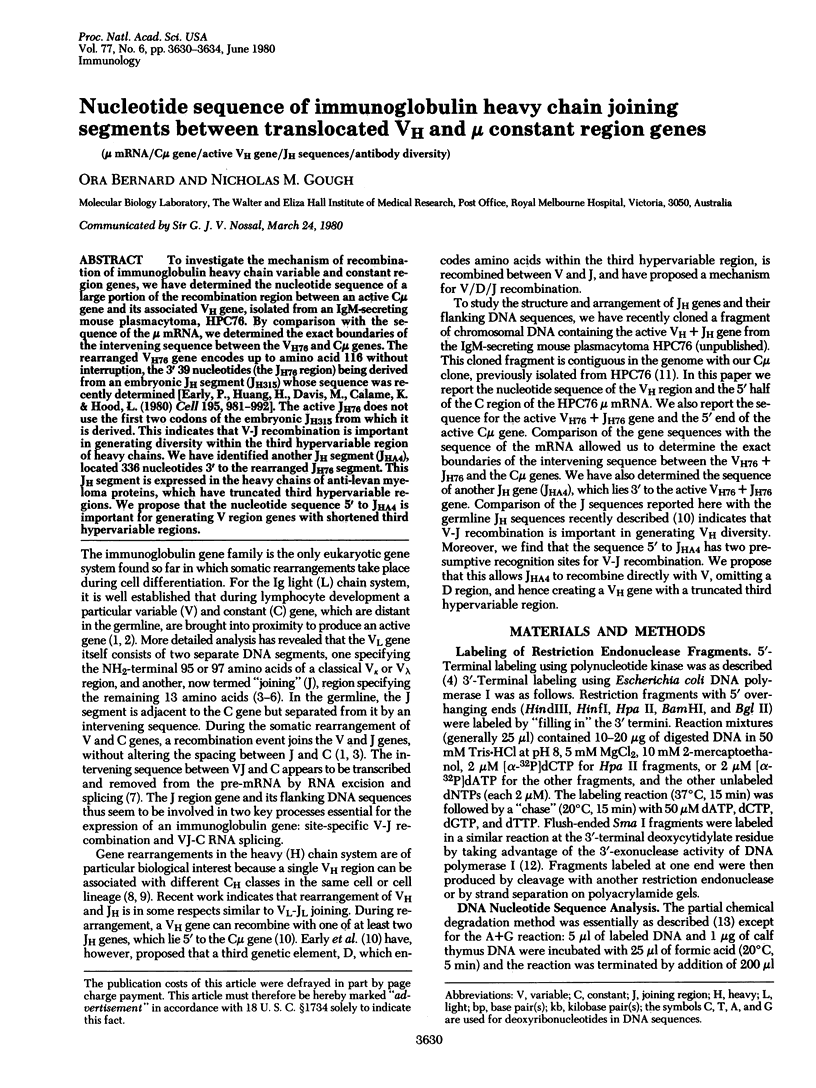
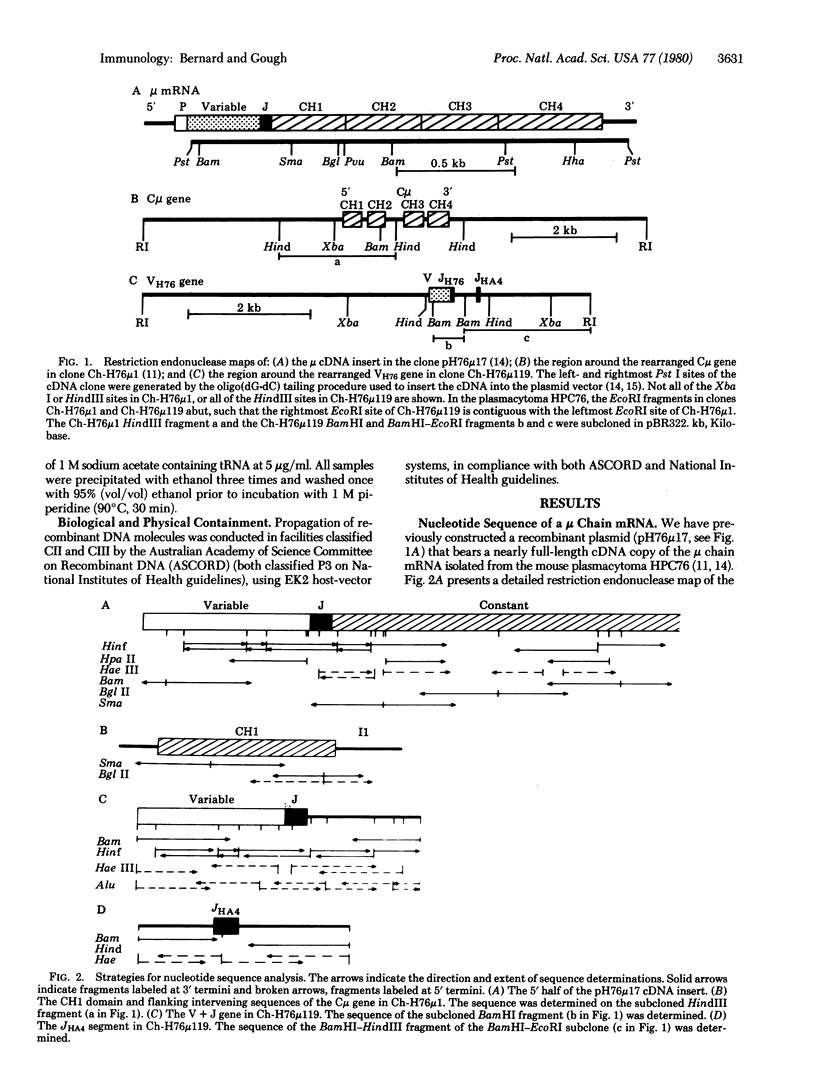
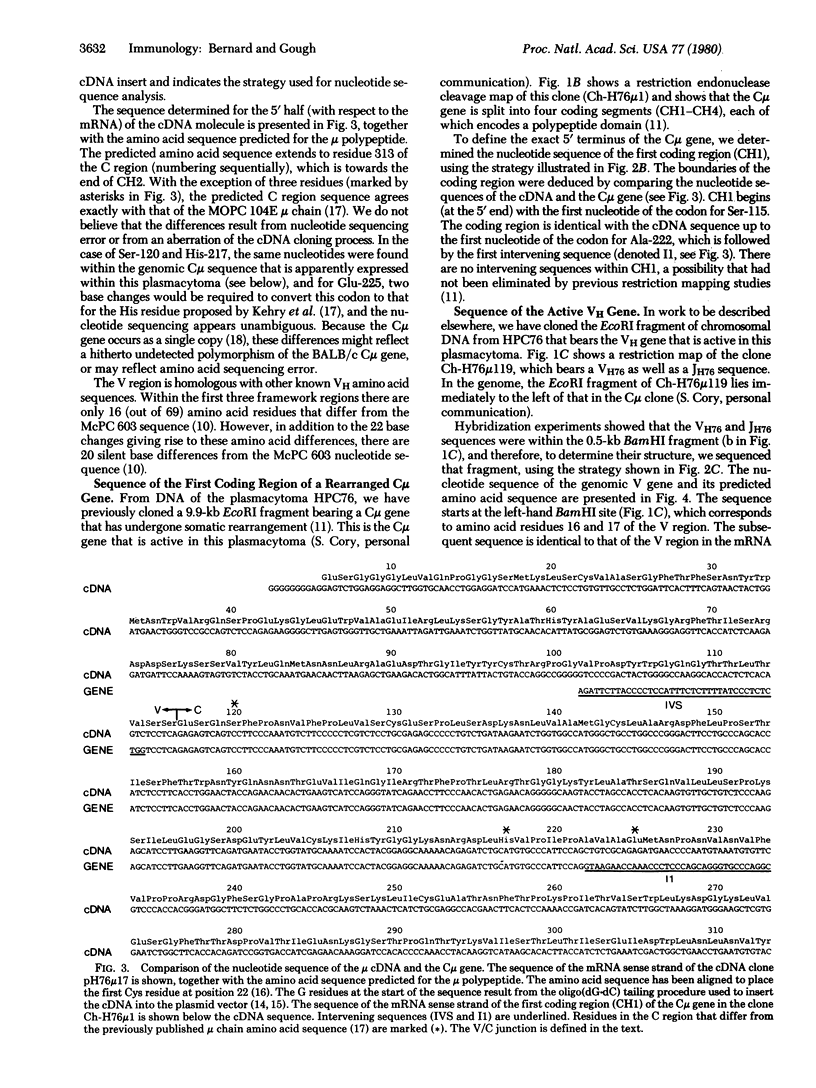
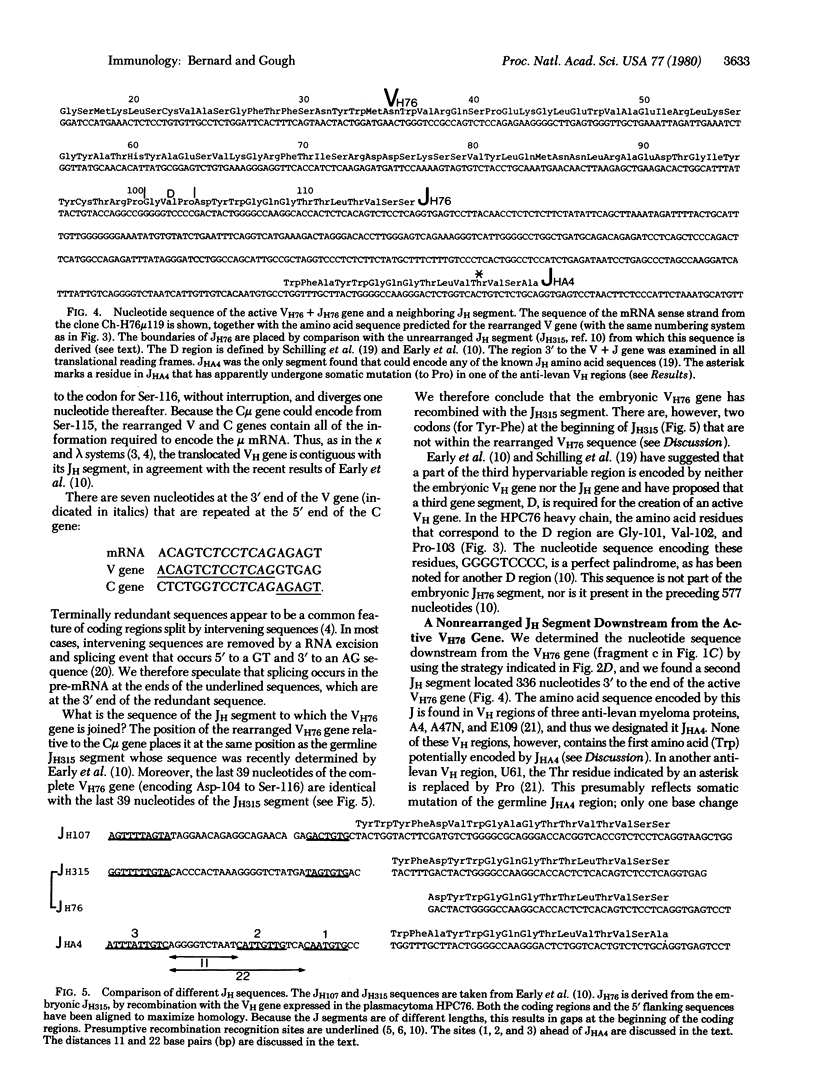
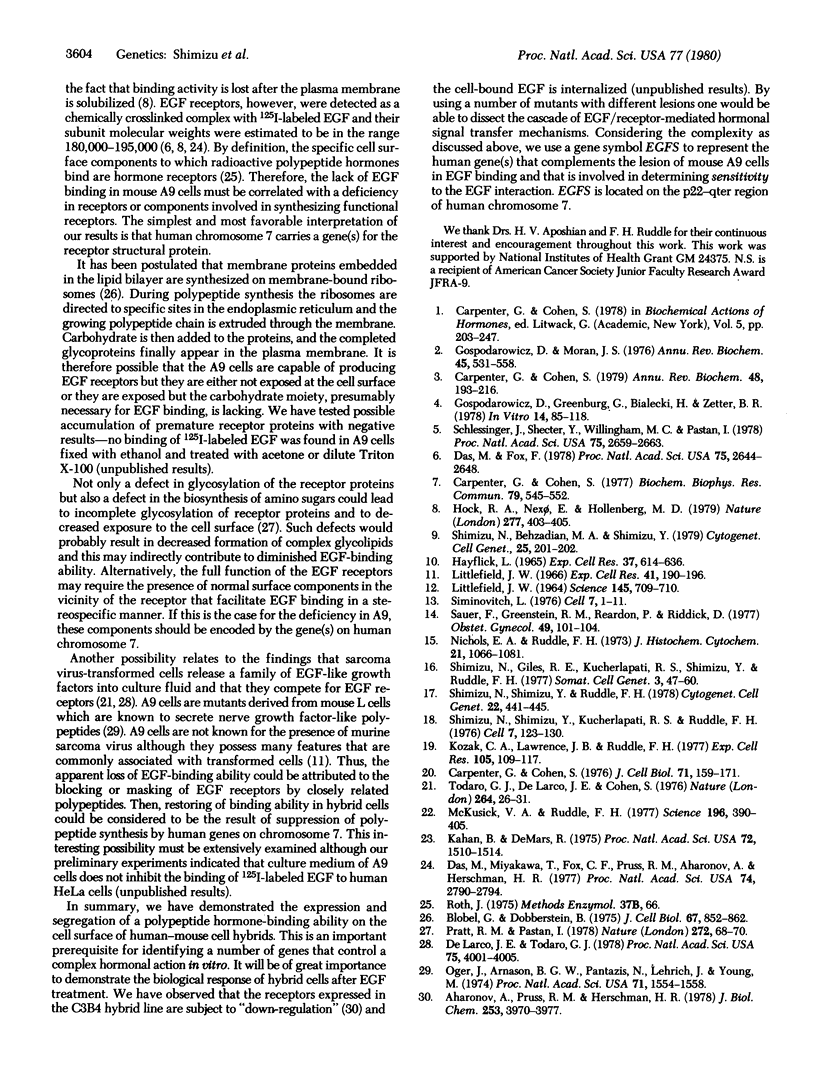
Selected References
These references are in PubMed. This may not be the complete list of references from this article.
- Aharonov A., Pruss R. M., Herschman H. R. Epidermal growth factor. Relationship between receptor regulation and mitogenesis in 3T3 cells. J Biol Chem. 1978 Jun 10;253(11):3970–3977. [PubMed] [Google Scholar]
- Blobel G., Dobberstein B. Transfer of proteins across membranes. II. Reconstitution of functional rough microsomes from heterologous components. J Cell Biol. 1975 Dec;67(3):852–862. doi: 10.1083/jcb.67.3.852. [DOI] [PMC free article] [PubMed] [Google Scholar]
- Carpenter G., Cohen S. 125I-labeled human epidermal growth factor. Binding, internalization, and degradation in human fibroblasts. J Cell Biol. 1976 Oct;71(1):159–171. doi: 10.1083/jcb.71.1.159. [DOI] [PMC free article] [PubMed] [Google Scholar]
- Carpenter G., Cohen S. Epidermal growth factor. Annu Rev Biochem. 1979;48:193–216. doi: 10.1146/annurev.bi.48.070179.001205. [DOI] [PubMed] [Google Scholar]
- Carpenter G., Cohen S. Influence of lectins on the binding of 125I-labeled EGF to human fibroblasts. Biochem Biophys Res Commun. 1977 Nov 21;79(2):545–552. doi: 10.1016/0006-291x(77)90192-9. [DOI] [PubMed] [Google Scholar]
- Das M., Fox C. F. Molecular mechanism of mitogen action: processing of receptor induced by epidermal growth factor. Proc Natl Acad Sci U S A. 1978 Jun;75(6):2644–2648. doi: 10.1073/pnas.75.6.2644. [DOI] [PMC free article] [PubMed] [Google Scholar]
- Das M., Miyakawa T., Fox C. F., Pruss R. M., Aharonov A., Herschman H. R. Specific radiolabeling of a cell surface receptor for epidermal growth factor. Proc Natl Acad Sci U S A. 1977 Jul;74(7):2790–2794. doi: 10.1073/pnas.74.7.2790. [DOI] [PMC free article] [PubMed] [Google Scholar]
- Gospodarowicz D., Greenburg G., Bialecki H., Zetter B. R. Factors involved in the modulation of cell proliferation in vivo and in vitro: the role of fibroblast and epidermal growth factors in the proliferative response of mammalian cells. In Vitro. 1978 Jan;14(1):85–118. doi: 10.1007/BF02618177. [DOI] [PubMed] [Google Scholar]
- Gospodarowicz D., Moran J. S. Growth factors in mammalian cell culture. Annu Rev Biochem. 1976;45:531–558. doi: 10.1146/annurev.bi.45.070176.002531. [DOI] [PubMed] [Google Scholar]
- HAYFLICK L. THE LIMITED IN VITRO LIFETIME OF HUMAN DIPLOID CELL STRAINS. Exp Cell Res. 1965 Mar;37:614–636. doi: 10.1016/0014-4827(65)90211-9. [DOI] [PubMed] [Google Scholar]
- Hock R. A., Nexø E., Hollenberg M. D. Isolation of the human placenta receptor for epidermal growth factor-urogastrone. Nature. 1979 Feb 1;277(5695):403–405. doi: 10.1038/277403a0. [DOI] [PubMed] [Google Scholar]
- Kahan B., DeMars R. Localized Derepression on the Human Inactive X Chromosone in Mouse-Human Cell Hybrids. Proc Natl Acad Sci U S A. 1975 Apr;72(4):1510–1514. doi: 10.1073/pnas.72.4.1510. [DOI] [PMC free article] [PubMed] [Google Scholar]
- Kozak C. A., Lawrence J. B., Ruddle F. H. A sequential staining technique for the chromosomal analysis of the interspecific mouse/hamster and mouse/human somatic cell hybrids. Exp Cell Res. 1977 Mar 1;105(1):109–117. doi: 10.1016/0014-4827(77)90156-2. [DOI] [PubMed] [Google Scholar]
- LITTLEFIELD J. W. SELECTION OF HYBRIDS FROM MATINGS OF FIBROBLASTS IN VITRO AND THEIR PRESUMED RECOMBINANTS. Science. 1964 Aug 14;145(3633):709–710. doi: 10.1126/science.145.3633.709. [DOI] [PubMed] [Google Scholar]
- Littlefield J. W. The use of drug-resistant markers to study the hybridization of mouse fibroblasts. Exp Cell Res. 1966 Jan;41(1):190–196. doi: 10.1016/0014-4827(66)90558-1. [DOI] [PubMed] [Google Scholar]
- McKusick V. A., Ruddle F. H. The status of the gene map of the human chromosomes. Science. 1977 Apr 22;196(4288):390–405. doi: 10.1126/science.850784. [DOI] [PubMed] [Google Scholar]
- Nichols E. A., Ruddle F. H. A review of enzyme polymorphism, linkage and electrophoretic conditions for mouse and somatic cell hybrids in starch gels. J Histochem Cytochem. 1973 Dec;21(12):1066–1081. doi: 10.1177/21.12.1066. [DOI] [PubMed] [Google Scholar]
- Oger J., Arnason B. G., Pantazis N., Lehrich J., Young M. Synthesis of nerve growth factor by L and 3T3 cells in culture. Proc Natl Acad Sci U S A. 1974 Apr;71(4):1554–1558. doi: 10.1073/pnas.71.4.1554. [DOI] [PMC free article] [PubMed] [Google Scholar]
- Pratt R. M., Pastan I. Decreased binding of epidermal growth factor to BALB/c 3T3 mutant cells defective in glycoprotein synthesis. Nature. 1978 Mar 2;272(5648):68–70. doi: 10.1038/272068a0. [DOI] [PubMed] [Google Scholar]
- Roth J. Assay of peptide hormones using cell receptors: application to insulin and to human growth hormone. Methods Enzymol. 1975;37:66–82. doi: 10.1016/s0076-6879(75)37006-7. [DOI] [PubMed] [Google Scholar]
- Sauer F., Greenstein R. M., Reardon P., Riddick D. H. Secondary amenorrhea associated with balanced X-autosome translocation. Obstet Gynecol. 1977 Jan;49(1):101–104. [PubMed] [Google Scholar]
- Schlessinger J., Shechter Y., Willingham M. C., Pastan I. Direct visualization of binding, aggregation, and internalization of insulin and epidermal growth factor on living fibroblastic cells. Proc Natl Acad Sci U S A. 1978 Jun;75(6):2659–2663. doi: 10.1073/pnas.75.6.2659. [DOI] [PMC free article] [PubMed] [Google Scholar]
- Shimizu N., Giles R. E., Kucherlapati R. S., Shimizu Y., Ruddle F. H. Somatic cell genetic assignment of the human gene for mitochondrial NADP-linked isocitrate dehydrogenase to the long arm of chromosome 15. Somatic Cell Genet. 1977 Jan;3(1):47–60. doi: 10.1007/BF01550986. [DOI] [PubMed] [Google Scholar]
- Shimizu N., Shimizu Y., Kucherlapati R. S., Ruddle F. H. Immunochemical detection of human enzymes in hybrid cells. Cell. 1976 Jan;7(1):123–130. doi: 10.1016/0092-8674(76)90262-2. [DOI] [PubMed] [Google Scholar]
- Shimizu N., Shimizu Y., Ruddle F. H. Assignment of the human mitochondrial NAD-linked malate dehydrogenase gene to the p22 leads to qter region of chromosome 7. Cytogenet Cell Genet. 1978;22(1-6):441–445. doi: 10.1159/000130992. [DOI] [PubMed] [Google Scholar]
- Siminovitch L. On the nature of hereditable variation in cultured somatic cells. Cell. 1976 Jan;7(1):1–11. doi: 10.1016/0092-8674(76)90249-x. [DOI] [PubMed] [Google Scholar]
- Todaro G. J., De Larco J. E., Cohen S. Transformation by murine and feline sarcoma viruses specifically blocks binding of epidermal growth factor to cells. Nature. 1976 Nov 4;264(5581):26–31. doi: 10.1038/264026a0. [DOI] [PubMed] [Google Scholar]
- de Larco J. E., Todaro G. J. Growth factors from murine sarcoma virus-transformed cells. Proc Natl Acad Sci U S A. 1978 Aug;75(8):4001–4005. doi: 10.1073/pnas.75.8.4001. [DOI] [PMC free article] [PubMed] [Google Scholar]


